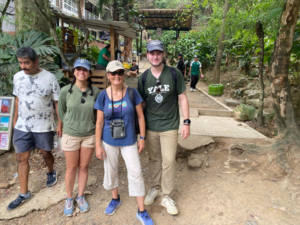COP16 Dispatch: Week 2 Exploring the Hill of the Three Crosses
By Zohra Zahir, David Baldwin, and Jeannine Cavender-Bares
This morning, four of us set out early for a hike to one of Cali’s most iconic spots: Cerro de las Tres Cruces, or the Hill of the Three Crosses. Known for its scenic views and historical significance, this hike promised not just a physical challenge but also a deep connection to the region’s natural and geological wonders. Here’s a summary of our adventure on this beautiful hillside, towering over Cali, Colombia.

Route recorded on Strava Oct. 27, 2024. 5.19 km, 402 m elevation gain.
The trail is only about 5.6 km round-trip, but don’t let the distance fool you—it’s steep and demanding, with a positive gradient of 411 m. The path is well-defined and carefully maintained, offering a rugged but rewarding journey to the top. We climbed from an altitude of 1,010 m up to 1,440 m, reaching one of Cali’s highest vantage points, with views that stretched far and wide. Despite the early hour, we were joined by many other hikers and locals, some already making their way down after a quick morning workout. The route is lined with vibrant juice stalls near the top, waiting to refresh hikers with freshly squeezed juices—a perfect treat after the tough climb. At the summit, three towering crosses greet you, a well-known symbol for Cali locals and a rewarding sight for anyone who reaches the top. We all finally indulged in the fresh juices that had been tempting us on the way up.

ESA COP16 delegates at the base of the stairs after completing the hike to Las Tres Cruces. From left to right: unknown hiker, Zohra Zahir, Jeannine Cavender-Bares, and David Baldwin. Taken on October 27, 2024.
One of the most fascinating aspects of the hike was the diverse vegetation found along the trail. We encountered Clusia trees (Clusia rosea), a lipstick tree (Bixa orellana), as well as fig (Ficus spp.), mango (Mangifera spp.), papaya trees (Carica papaya), and a variety of other plants that thrive in this region of Colombia. The trail is lush, and most of it is covered by vegetation, providing shade and making the ascent a little easier. Even though the path winds through green spaces, occasional outcrops expose the unique geology underneath. The geology of Cerro de las Tres Cruces is a true testament to Colombia’s complex natural history.
According to Servicio Geológico Colombiano (SGC) report (1932), the hill’s foundation consists of volcanic and sedimentary layers that have witnessed countless years of geological change. The sedimentary rocks -alternate with sandstone and shales, adding to the color and texture of the rock formations. These rocks display fascinating shades of red, yellow, and black, each telling a story of its origin and transformation. In addition to the volcanic formations, carbonaceous layers known as the “Aguacatal horizon” are also present in the region. This part of the hill’s history ties back to an era when coal mining was a significant industry in the Aguacatal region. Although mining is no longer active here, traces of this past are visible in the layered structure of the rocks and the rich deposits of carbon still embedded in the hillside.

A Clusia rosea tree encountered during the hike to “The Three Crosses” (Las Tres Cruces) on October 27, 2024.
For anyone visiting Cali, hiking the Hill of the Three Crosses offers a unique mix of physical challenge, cultural insight, and natural beauty. It’s not just about the exercise—it’s a journey through Colombia’s biodiversity and geological history. The hill serves as a “tutelary” landmark for the city, standing as both a spiritual and recreational place. Standing at the summit, sipping fresh juice with the city sprawling below, you get a sense of the deep connection between Cali and its natural surroundings.
The Hill of the Three Crosses is more than just a hiking spot; it’s a reminder of how landscapes shape and are shaped by both people and time. So if you find yourself in Cali, Colombia, take a morning to hike Cerro de las Tres Cruces. Breathe in the fresh air, learn a bit about the rocks beneath your feet, and enjoy the stunning panoramic views. It’s a short but intense climb with rewards that go far beyond the summit.

View the summit of “Las Tres Cruces,” showing the worn trails in the sedimentary rock. Taken on October 27, 2024.

An unknown hiker, Zohra Zahir, Jeannine Cavender-Bares, and David Baldwin standing at the summit of “The Three Crosses” (Las Tres Cruces). Taken on October 27, 2024.
Disclaimer: Opinions are solely those of the guest contributor and not an official ESA policy or position.